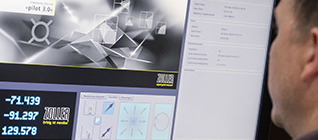Flatness Tolerances
The flatness of a casting can be measured by supporting the surface in question on three widely separated points to establish a datum and measuring the deviation from that plane by the use of feeler gauges.
The flatness tolerance is the total deviation permitted from the datum and consists of the distance between two parallel planes within which the entire surface so tolerated must lie.
|
Pressure Diecasting |
|
|
Maximum Dimension |
|
|
Up to 75mm |
within 0.2 |
|
for each additional 25mm |
add 0.075 |
|
Gravity Diecasting |
|
|
Maximum Dimension |
|
|
Up to 150mm |
within 0.5 |
|
for each additional 25mm |
add 0.075 |
|
Sand Casting |
|
|
Maximum Dimension |
|
|
Up to 150mm |
within 0.75 |
|
for each additional 25mm |
add 0.075 |
The values shown represent production practice at the most economical level. Greater accuracy involving extra work or care in production should be specified only when and where necessary.
Notes for Designers of Non-Ferrous Castings
DOWNLOAD NOW Guides
HOW can MRT Castings help you?
I want...
- Select what you need
- a complete solution
- to develop a new component from initial concept
- advice on what processes are best suited to my component
- prototypes before committing to production tooling
- to re-shore production to the UK from overseas
- a new supplier to use existing tooling
- to convert a machined from solid part to a casting
- a supplier who can meet stringent quality requirements
New at MRT Blogs
Visit us at stand C240 on the 4th, 5th & 6th of February 2025.
Read MoreMRT Secure Cyber Essential Plus Standard
17th Jul 2023
MRT Castings is proud to announce that it has achieved certification to the ‘Cyber Essentials Plus’ standard.
Read MoreAluminium diecasting specialists MRT Castings secured the prestigious ‘Company of the Year’ title at the recent UK Cast Metals Industry Awards 2022.
Read More




